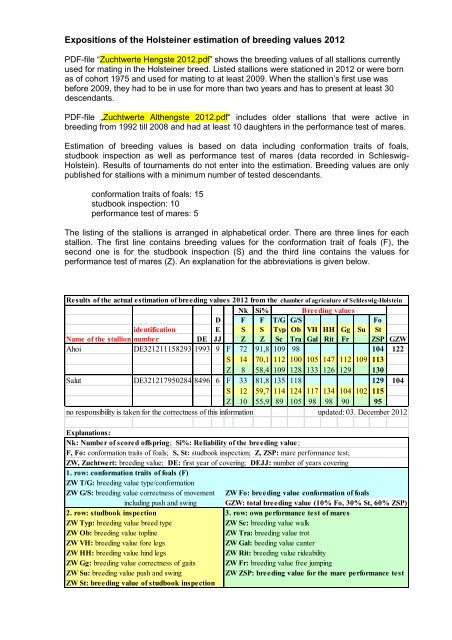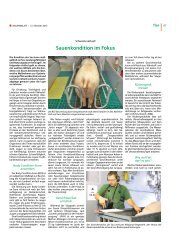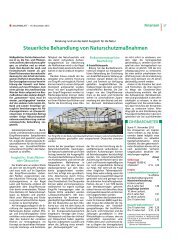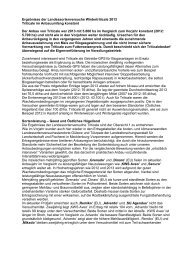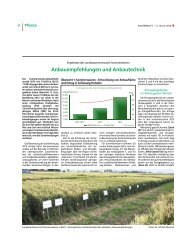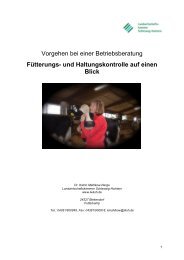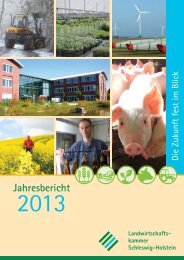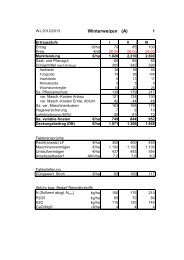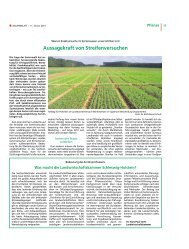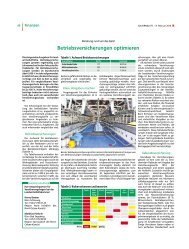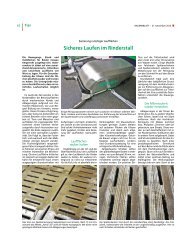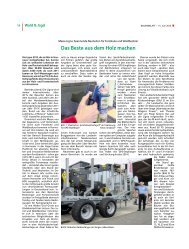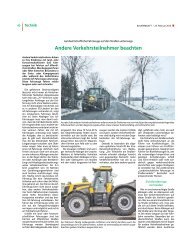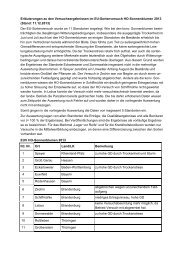Zuchtwerte Hengste - Landwirtschaftskammer Schleswig-Holstein
Zuchtwerte Hengste - Landwirtschaftskammer Schleswig-Holstein
Zuchtwerte Hengste - Landwirtschaftskammer Schleswig-Holstein
Create successful ePaper yourself
Turn your PDF publications into a flip-book with our unique Google optimized e-Paper software.
Expositions of the <strong>Holstein</strong>er estimation of breeding values 2012<br />
PDF-file “<strong>Zuchtwerte</strong> <strong>Hengste</strong> 2012.pdf” shows the breeding values of all stallions currently<br />
used for mating in the <strong>Holstein</strong>er breed. Listed stallions were stationed in 2012 or were born<br />
as of cohort 1975 and used for mating to at least 2009. When the stallion’s first use was<br />
before 2009, they had to be in use for more than two years and has to present at least 30<br />
descendants.<br />
PDF-file „<strong>Zuchtwerte</strong> Althengste 2012.pdf“ includes older stallions that were active in<br />
breeding from 1992 till 2008 and had at least 10 daughters in the performance test of mares.<br />
Estimation of breeding values is based on data including conformation traits of foals,<br />
studbook inspection as well as performance test of mares (data recorded in <strong>Schleswig</strong>-<br />
<strong>Holstein</strong>). Results of tournaments do not enter into the estimation. Breeding values are only<br />
published for stallions with a minimum number of tested descendants.<br />
conformation traits of foals: 15<br />
studbook inspection: 10<br />
performance test of mares: 5<br />
The listing of the stallions is arranged in alphabetical order. There are three lines for each<br />
stallion. The first line contains breeding values for the conformation trait of foals (F), the<br />
second one is for the studbook inspection (S) and the third line contains the values for<br />
performance test of mares (Z). An explanation for the abbreviations is given below.<br />
Results of the actual estimation of breeding values 2012 from the chamber of agriculure of <strong>Schleswig</strong>-<strong>Holstein</strong><br />
Nk Si% Breeding values<br />
D F F T/G G/S Fo<br />
identification E S S Typ Ob VH HH Gg Su St<br />
Name of the stallion number DE JJ Z Z Sc Tra Gal Rit Fr ZSP GZW<br />
Ahoi DE321211158293 1993 9 F 72 91,8 109 98 104 122<br />
S 14 70,1 112 100 105 147 112 109 113<br />
Z 8 58,4 109 128 133 126 129 130<br />
Salut DE321217950284 8496 6 F 33 81,8 135 118 129 104<br />
S 12 59,7 114 124 117 134 104 102 115<br />
Z 10 55,9 89 105 98 98 90 95<br />
no responsibility is taken for the correctness of this information updated: 03. December 2012<br />
Explanations:<br />
Nk: Number of scored offspring; Si%: Reliability of the breeding value ;<br />
F, Fo: conformation traits of foals; S, St: studbook inspection; Z, ZSP: mare performance test;<br />
ZW, Zuchtwert: breeding value; DE: first year of covering; DEJJ: number of years covering<br />
1. row: conformation traits of foals (F)<br />
ZW T/G: breeding value type/conformation<br />
ZW G/S: breeding value correctness of movement ZW Fo: breeding value conformation of foals<br />
including push and swing GZW: total breeding value (10% Fo, 30% St, 60% ZSP)<br />
2. row: studbook inspection 3. row: own performance test of mares<br />
ZW Typ: breeding value breed type ZW Sc: breeding value walk<br />
ZW Ob: breeding value topline ZW Tra: breeding value trot<br />
ZW VH: breeding value fore legs ZW Gal: beeding value canter<br />
ZW HH: breeding value hind legs ZW Rit: breeding value rideability<br />
ZW Gg: breeding value correctness of gaits ZW Fr: breeding value free jumping<br />
ZW Su: breeding value push and swing ZW ZSP: breeding value for the mare performance test<br />
ZW St: breeding value of studbook inspection
How does the estimation of breeding values work?<br />
- From mark to breeding value -<br />
Who does not know this: winner + winner = dreamlike breeding success or disappointing<br />
average?<br />
Every breeder already had to experience that a horse does not always transmit like it’s merit<br />
let hope for. Why is that?<br />
One of the basic formulas of animal breeding says, that you can explain the animal’s merit by<br />
the collective effect of genetics and environment.<br />
measurable merit (assessment/mark) =<br />
breeding value (genotype) + environmental influence<br />
So the breeding value cannot be measured straight on the horse. Only on the surface visible<br />
capacities are measurable (ratings, marks, stick-measure,...). They are determined on the<br />
one hand by the genetic tendency (genotype, breeding value) and on the other hand by<br />
external influences (breeding, keeping, feeding, rider, judge committee, floor incident,<br />
season,...). At BLUP-estimation of breeding values with the so called “animal model” it is<br />
tried to part the genetic effects from external influences to get for the “true” breeding value an<br />
estimated value as exactly as possible. To accomplish this all available performance data<br />
from all horses of the population, taking all kinsmanlike relations between them into account,<br />
get evaluated.<br />
So all performances, that horses get of <strong>Holstein</strong>er association’s registration- and<br />
assessment-commissions at conformation traits of foals and studbook inspections or of<br />
experts at performance tests of mares, are basis for the estimation of breeding values. Withal<br />
it makes no odds ,whether a foal was prizewinning, whether a mare got the association’s<br />
award or had an elected son. Features, only rated on a few horses, cannot be regarded in<br />
the estimation of breeding values. Such an uneven distribution can statistically not be solved<br />
satisfying and would end in heavy distortions. It would be optimal for the estimation of<br />
breeding values, if all performances from all horses of the population were available without<br />
any selection, like it is for example at the conformation traits of foals.<br />
Experiences with siblings or descendants were emotionally included in the breeding decision.<br />
But follows from this an impartial image? Perhaps you just see only some positive or<br />
negative individual cases.<br />
So the own performance cannot predicate too much of expected inheritance performance.<br />
That is on the one hand because these performances are influenced by environmental<br />
effects (look above) and on the other hand there are several genes involved in the<br />
characteristic of feature of performance. With every transmission on the descendants the<br />
genes become dispersed by chance. You cannot spot which descendant has got which<br />
genes from it’s parents. But because related horses have parts of their genome in common,<br />
the performance data of related animals are called on the estimation of breeding values. A<br />
mare’s own performance contributes only a small part to her breeding value. All the other<br />
available performances of her relations (assessments of father, mother, descendants and<br />
other descendants of father and mother, and so on...) have also influence on the mare’s<br />
breeding value.<br />
The BLUP-estimation of breeding values tries with help of complex mathematical-statistical<br />
methods to eliminate not genetically given external influences, which can affect the horse’s<br />
performance, as far as possible. This comes by regarding the date of the performance test of<br />
mares or the mare’s age and the year of her registration at studbook inspection in the<br />
estimation of breeding values. But that only works, if there are enough horses that have such<br />
effects presently.
Basically at estimation of breeding values a horse with it’s own performance is compared to<br />
other horses in a comparison-group, where you can suppose that all performances were<br />
produced on as equal as possible terms.<br />
The quality of the comparison-group is therefore important to the level of the breeding value.<br />
For example a nine at walk lead to higher breeding values than a nine or ten at free jumping,<br />
because there are usually very little nines and almost no tens assigned at walk; at free<br />
jumping on the other hand nines and tens occur more often. With a nine at walk a mare<br />
stands out more clearly from the others than for example with a ten at free jumping.<br />
In contrast to pure marks, for example at the studbook inspection where they are totally<br />
independent of other horses’ marks and remain for a mare lifelong, the breeding value can<br />
change.<br />
The breeding value is defined as deviation from the population’s average. That means, a<br />
horse’s breeding value has to be spotted in relation to the other horses.<br />
After all the best equids should ever be chosen for breeding.<br />
Because a breeding value has always been estimated in relation to the other horses of that<br />
population, it can only be valid in that context. Breeding values from different estimations are<br />
therefore anything but comparable.<br />
The breeding value is not absolute and forever definite, but can change every year.<br />
New assessments from conformation traits of foals, studbook inspections and performance<br />
tests of mares were added each year. Because of this, the estimation of breeding values<br />
takes new data as a basis every year.<br />
Withal it is normal, that breeding values of older equids decrease a little every year. When<br />
there is breeding improvement in the population younger horses should be better than older<br />
ones and the performances of older horses will relatively diminish in relation to performances<br />
of younger ones.


